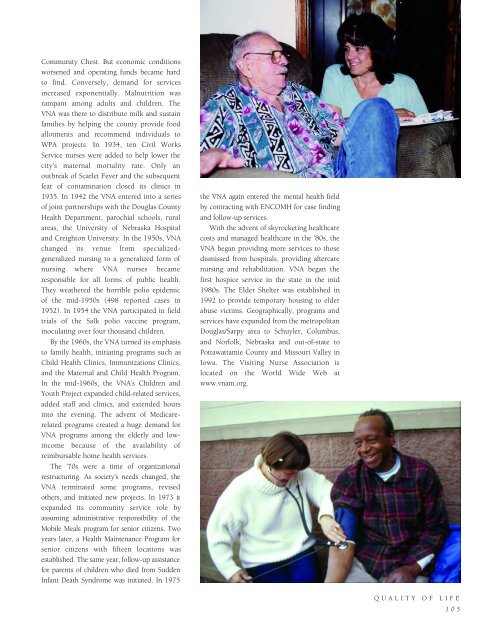Historic Omaha
An illustrated history of Omaha and the Douglas County area, paired with the histories of companies, families and organizations that make the region great.
An illustrated history of Omaha and the Douglas County area, paired with the histories of companies, families and organizations that make the region great.
Create successful ePaper yourself
Turn your PDF publications into a flip-book with our unique Google optimized e-Paper software.
Community Chest. But economic conditions<br />
worsened and operating funds became hard<br />
to find. Conversely, demand for services<br />
increased exponentially. Malnutrition was<br />
rampant among adults and children. The<br />
VNA was there to distribute milk and sustain<br />
families by helping the county provide food<br />
allotments and recommend individuals to<br />
WPA projects. In 1934, ten Civil Works<br />
Service nurses were added to help lower the<br />
city’s maternal mortality rate. Only an<br />
outbreak of Scarlet Fever and the subsequent<br />
fear of contamination closed its clinics in<br />
1935. In 1942 the VNA entered into a series<br />
of joint partnerships with the Douglas County<br />
Health Department, parochial schools, rural<br />
areas, the University of Nebraska Hospital<br />
and Creighton University. In the 1950s, VNA<br />
changed its venue from specializedgeneralized<br />
nursing to a generalized form of<br />
nursing where VNA nurses became<br />
responsible for all forms of public health.<br />
They weathered the horrible polio epidemic<br />
of the mid-1950s (498 reported cases in<br />
1952). In 1954 the VNA participated in field<br />
trials of the Salk polio vaccine program,<br />
inoculating over four thousand children.<br />
By the 1960s, the VNA turned its emphasis<br />
to family health, initiating programs such as<br />
Child Health Clinics, Immunizations Clinics,<br />
and the Maternal and Child Health Program.<br />
In the mid-1960s, the VNA’s Children and<br />
Youth Project expanded child-related services,<br />
added staff and clinics, and extended hours<br />
into the evening. The advent of Medicarerelated<br />
programs created a huge demand for<br />
VNA programs among the elderly and lowincome<br />
because of the availability of<br />
reimbursable home health services.<br />
The ’70s were a time of organizational<br />
restructuring. As society’s needs changed, the<br />
VNA terminated some programs, revised<br />
others, and initiated new projects. In 1973 it<br />
expanded its community service role by<br />
assuming administrative responsibility of the<br />
Mobile Meals program for senior citizens. Two<br />
years later, a Health Maintenance Program for<br />
senior citizens with fifteen locations was<br />
established. The same year, follow-up assistance<br />
for parents of children who died from Sudden<br />
Infant Death Syndrome was initiated. In 1975<br />
the VNA again entered the mental health field<br />
by contracting with ENCOMH for case finding<br />
and follow-up services.<br />
With the advent of skyrocketing healthcare<br />
costs and managed healthcare in the ’80s, the<br />
VNA began providing more services to those<br />
dismissed from hospitals, providing aftercare<br />
nursing and rehabilitation. VNA began the<br />
first hospice service in the state in the mid<br />
1980s. The Elder Shelter was established in<br />
1992 to provide temporary housing to elder<br />
abuse victims. Geographically, programs and<br />
services have expanded from the metropolitan<br />
Douglas/Sarpy area to Schuyler, Columbus,<br />
and Norfolk, Nebraska and out-of-state to<br />
Pottawattamie County and Missouri Valley in<br />
Iowa. The Visiting Nurse Association is<br />
located on the World Wide Web at<br />
www.vnam.org.<br />
QUALITY OF LIFE<br />
105
















